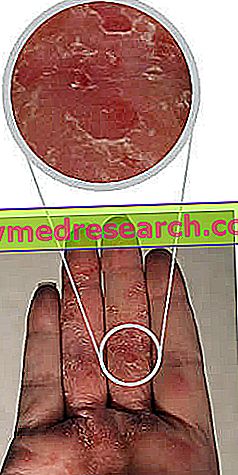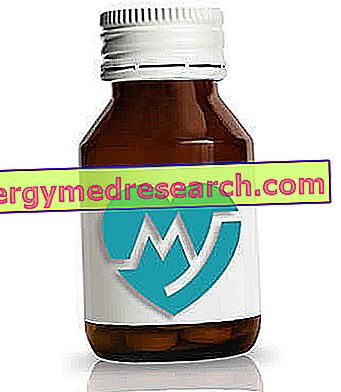Generality
Dyshidrosis, also known as dyshidrotic eczema or pompholix, is a dermatitis, or an inflammatory disease of the skin.

A characteristic sign of dehydrosis is the appearance of small blisters on the palms of the hands, on the sides of the fingers and on the soles of the feet. Bladders usually remain 3-4 weeks; in this time, they dry up and "come away", leaving the underlying skin red and extremely sensitive.
Corticosteroid medications (in the form of creams, ointments or oral tablets), photodynamic therapy, and some immunosuppressive drugs may be helpful to treat dyshidrotic eczema.
What is dyshidrosis?
Dyshidrosis is an inflammatory disease of the skin characterized by the appearance of small blisters on the palms of the hands, on the sides of the fingers and, sometimes, on the soles of the feet.
Also known as dehydrotic eczema or pompholi, dehydrosis can be an acute phenomenon, which occurs suddenly and sporadically, or chronically; in the latter case, dehydrosis occurs periodically, perhaps in particular seasons of the year or after contact with certain substances.
Dermatitis or eczema?
The terms eczema and dermatitis are synonymous and can be used indistinctly, as both mean inflammation of the skin .
VARIOUS TYPES OF ECZEMA
In addition to dyshidrotic eczema, there are other eczemas. The most common and well known are:
- Atopic eczema, also known as atopic dermatitis . It is a skin inflammation whose origin is both a genetic component and an environmental component. It affects most newborns and is often associated with asthma and hay fever.
- Contact eczema, more commonly called contact dermatitis . The inflammatory skin condition arises after contact with certain substances, which the body considers to be dangerous, even if they are not. It is, in fact, an allergic reaction.
- Varicose eczema . It is an inflammation of the skin that takes place in the legs of those who suffer from varicose veins.
- Xerotic eczema, also known as asteatosic or xerotic eczema . It is at the origin of a hardening and excessive dryness of the skin, which becomes extremely dry and dehydrated. It is typical of old age.
- Nummular eczema, also called discoid eczema . It is a dermatitis that causes red-brownish oval or circular spots at the level of: forearms, hands, feet, trunk (chest, belly and back) and legs.
Epidemiology
Dyshidrosis has an unknown incidence, since, appearing in association with other skin disorders, it is very often underdiagnosed.
According to some research, it seems to have a seasonal pattern (as it is more frequent in the period between spring and summer) and a predilection for people between 30 and 40 years.
Causes
The precise causes of dehydrosis are unknown. Usually, the disease is associated with atopic dermatitis (atopic eczema) or an allergic reaction, such as hay fever .
In some cases, the appearance of blisters is related to allergic colds ( allergic rhinitis ), typical of the spring / summer season.
RISK FACTORS
The onset of dehydrosis is favored by some factors, such as stress, exposure to certain metals, contact with certain irritants and atopic eczema.
- Stress . It has been observed that people with recurrent / chronic dehydrotic eczema are more prone to new episodes of dehydrosis in times of stress.
- Exposure to certain metals . Based on some laboratory tests, exposure to chromium, cobalt and nickel promotes the onset of dehydrotic eczema.
- Contact with certain irritants . Some individuals have an extremely sensitive skin, which, in contact with certain irritants, develops the classic blisters of dyshidrosis.
- Atopic eczema . Some individuals subject to atopic eczema are also protagonists of episodes of dyshidrosis.
Symptoms and Complications
To learn more: Symptoms Dyshidrosis
Dyshidrosis is characterized by the formation of small blisters on the palms of the hands, on the sides of the fingers and, sometimes, on the soles of the feet. In medicine, the appearance of such bladders is called vesicular exanthema .
CHARACTERISTICS OF THE VESICULAR EXTENSION
The small blisters (1-2 mm in diameter) of the dehydrotic eczema are full of liquid and in close contact with each other; in some individuals, they are so close to each other that they appear to form a single large bladder.
They can cause itching and / or pain and take about 3-4 weeks to dry spontaneously.
After they have dried and flaked from the formation area, the underlying skin remains red and becomes, for a few days, more sensitive than normal.
The sites of appearance of the vesicular rash are: the center of the palm of both hands, the sides of the fingers and the plant of both feet. Hands and fingers are interested in most patients; the feet, on the other hand, are only affected in some individuals.
WHEN TO REFER TO THE DOCTOR?
Patients with dyshidrosis should contact their doctor if the vesicular rash, instead of healing spontaneously, continues to reform without a break.
COMPLICATIONS
The complications of dehydrosis are related to the itching and pain caused by blisters. In fact, these two sensations:
- They prevent hands from moving freely and holding objects
- They lead to scratching, to the point of injuring the skin and favoring the onset of bacterial infections
Diagnosis
It is possible to diagnose dehydrosis only with an objective examination, as laboratory tests on the content of the bladders or on the patient's blood have no element / abnormal value.
If the doctor makes use of some particular laboratory test, he does it for a completely precautionary purpose, to make sure that the rash has not been caused by other skin diseases with symptoms similar to dyshidrotic eczema (differential diagnosis).
DIFFERENTIAL DIAGNOSIS
If the doctor fears that the blisters on the feet are due to fungi (in this case athlete 's foot fungi), he can take a small sample of skin cells and have them analyzed in the laboratory. If, on the other hand, he has the doubt that the rash is the result of an allergic reaction not linked to dehydrosis, he subjects the patient to various allergy tests.
WHAT TO DO IN CASE OF INFECTION?
If, by scratching, the patient is injured, the skin lesions can be attacked by the bacteria and become infected, sometimes with very serious consequences.
If the doctor fears an ongoing infection, he can have a culture test performed on a skin swab (or skin swab), appropriately taken from the affected area. A positive culture test (confirming the presence of bacteria in skin lesions) would require the planning of an antibiotic therapy .
Treatment
The most appropriate therapeutic choice depends on the severity of the symptoms. In general, corticosteroid drugs (both topical and oral) are used, but if they are ineffective and dangerous for the patient, they can be replaced with other remedies, such as photodynamic therapy and immunosuppressants.
CORTICOSTEROID DRUGS FOR TOPICAL USE (OR LOCAL)
What are corticosteroids? Corticosteroids are powerful anti-inflammatory drugs, belonging to the steroid family (steroids are also hormones naturally present in the human body).
Types of topical corticosteroids (topical or local use means that the preparation is applied directly to the affected area). There are variable potency corticosteroids; furthermore, depending on the area affected and the severity of the dehydrosis, it is possible to apply them in the form of ointments or creams. For example, ointments are indicated for very severe dehydrotic eczemas, characterized by a large number of blisters; the creams, on the other hand, are suitable for moderate dehydrotic eczemas, characterized by a small number of blisters.
How are corticosteroids applied?

Side effects . At the first administration, the patient may experience a slight discomfort, to which, however, he gets used in a short time. The main side effects are: spider veins and thinning of the skin. Their appearance is usually due to prolonged use of the corticosteroid.
CORTICOSTEROID ORAL DRUGS
Main side effects of oral corticosteroids:
- Hypertension
- Weight gain
- Osteoporosis
Oral corticosteroids differ from topical corticosteroids only by the route of administration, which is by mouth, and by the type of side effects.
The most common oral corticosteroid is prednisone .
PHOTODYNAMIC THERAPY
Photodynamic therapy involves the use of a photosensitizing drug, for topical use, and a source of luminous radiation. The photosensitizing drug is a kind of cream, which, when applied to the area affected by the vesicular exanthem, makes the latter more susceptible to light; the light source, on the other hand, emits the ultraviolet rays necessary to destroy the abnormal skin cells, which became hyper-photosensitive after the application of the drug.
Photodynamic therapy is not very invasive, but its long-term effects are unknown; therefore, it is put into practice only if the corticosteroids have not been effective (or if it is necessary to suspend drug therapy).
THERAPY BASED ON IMMUNOSOPPRESSORS
Immunosuppressive drugs reduce inflammation, acting against the patient's immune system (NB: the immune system is the defensive barrier against threats from the external environment, such as viruses and bacteria).
In the case of dehydrosis, they are prescribed to limit the dosage of corticosteroids or when the latter are contraindicated.
The medicines used in these situations are tacrolimus and pimecrolimus, which are also indicated for the treatment of atopic eczema.
Warning: taking immunosuppressants makes the body more fragile, exposing it to a greater risk of infections.
OTHER REMEDIES
To alleviate the itchy sensation (especially when it is very intense), it can be useful to make cold / wet compresses on the affected area and take antihistamines (such as diphenhydramine ).
To speed up healing, witch hazel- based creams, a plant with anti-inflammatory and antioxidant powers, seem to have excellent effects.
Prognosis and prevention
More than a serious disease, dyshidrosis is a troublesome disease. In fact, if not treated properly, it can affect all manual activities, last for more than 3 or 4 weeks and give rise to skin infections.
PREVENTION
When the real causes of a disease are unknown, as in the case of dyshidrotic eczema, it is difficult to make adequate prevention.
For patients with recurrent dehydrosis, doctors only advise managing stress and avoiding contact with certain sensitizing substances.



